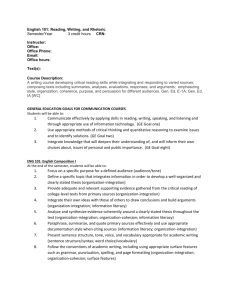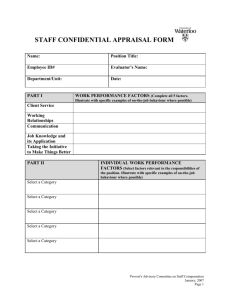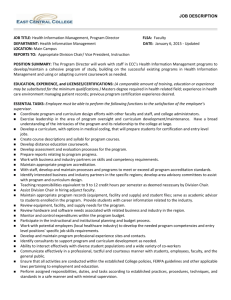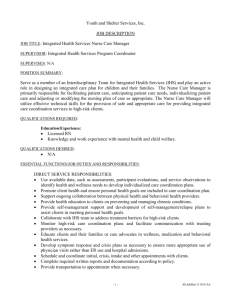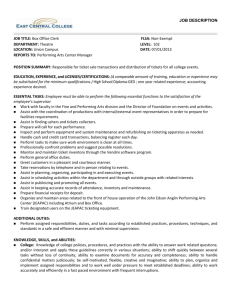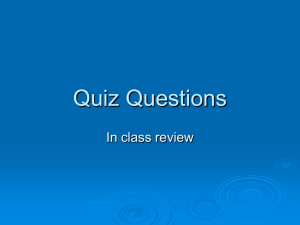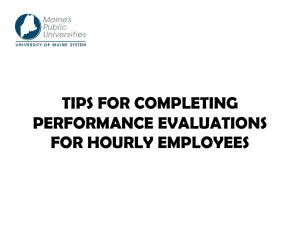Printable Performance Management Guide
advertisement
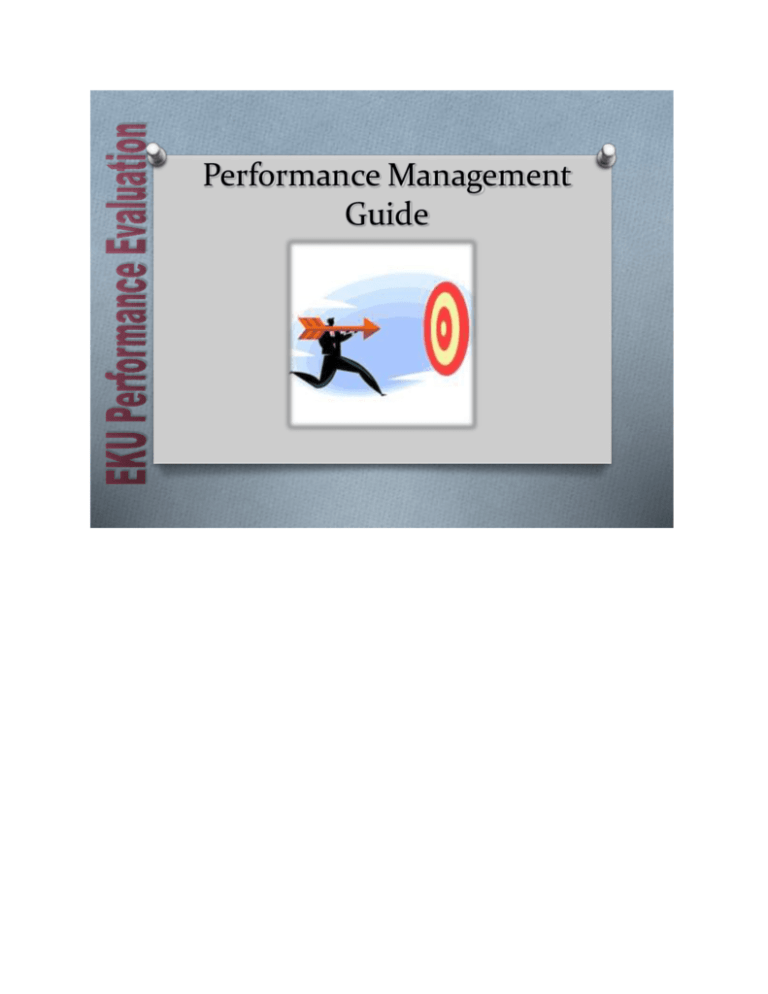
Performance Management Guide Table of Contents Introduction to Performance Management Performance Evaluation Purpose Performance Review Cycle Evaluation Due Dates per Cycle Best Practices Legal Considerations EKU Human Resources Policies & Procedures Page 3 3 4 4 5 5 Performance Planning When to Complete the Planning Stage Writing SMAART Goals Setting Expectations o Core Competencies o Duties, Goals & Objectives 10 11 12 Monitoring & Documenting Staff Performance Observing Performance Coaching & Feedback Documenting Performance Addressing Performance Issues 14 14 15 16 Annual Performance Review Preparing for the Annual Review Conducting the Review Meeting & Completing the Evaluation Form Rating Scale Reference 17 18 19 EKU Staff Performance Evaluations This guide is a reference for supervisors, managers, and EKU Staff who will be involved in the management and appraisal of EKU staff performance. It explains best practices in performance management with integrated instructions for completing EKU staff appraisal processes. Additional Resources Developing Effective Objectives or Goals Common Rating Errors & Biases Completed Evaluation Samples (web link) EKU Strategic Plan 2011 – 2015 (web link) 20 21 21 21 Contact HR Employee Development or (859) 6228874 for information or assistance. Introduction to Performance Management EKU Staff Performance Evaluation Purpose: Performance management involves the careful selection of employees, communication of work expectations, monitoring of performance, feedback and support for ongoing development and recognition for excellent performance. Performance management enhances organizational success through increased employee clarity regarding organizational goals and individual contributions toward goals. * EKU Faculty are evaluated under the Faculty Evaluation system. See the EKU Faculty Handbook, Part III for explanation of the Faculty Evaluation process. Performance Review Cycle Performance Management Cycle Planning: At the beginning of the review period, the manager and employee meet to set expectations regarding the work to be completed by the employee (job duties and goals) and how the job will be done (core competencies). Performance Planning for new staff is completed upon successful completion of the established orientation period of 90 days after his/her start date. Performing: Over the course of the review period, the employee works to achieve the expectations for the job. During that time, both the supervisor and employee should track performance. Ongoing feedback should be provided to the employee either informally or through interim discussions. Coaching and development opportunities should be provided to support the employee’s performance needs. The evaluator should maintain documentation of performance and feedback to assist in the annual review. Reviewing: At the end of each review period, both the supervisor and the employee summarize and evaluate performance using the evaluation form and participate in an annual performance review meeting to review progress, recognize success and plan for future development activities. Developing: While it is a formal element of the Performance Planning phase, there is a continual need to reassess employee needs and acquire the formal and informal resources to support development throughout the performance cycle. Cycle Due Dates Department Area Academic Administrative Cycle Dates July 1 – June 30 January 1 – December 31 Evaluation Due Date August 15 March 1 Best Practices Clear documentation of performance o Do not rely on memory or last minute compilation of information for the annual review. Doing so could lead to recency bias. Be consistent o All staff use the same evaluation form. The only differences should be the job specific duties and goals. Review meetings should be held in the same manner for each employee. Behavior-based NOT trait-based o Avoid focusing on attitudes. Remember, this is a performance review, not a personality review. Be specific, not general o Feedback about performance should be specific so the staff member knows what they are doing correctly, and/or what, exactly, they need to improve. Giving specific examples of performance can help both the evaluator and the staff member to understand performance issues or receive praise for good performance. Objective and job-related, NOT subjective or arbitrary o Focusing on the performance will help avoid ‘finger-pointing’ and blame. Keep in mind that performance improvement must involve conversation about how to solve issues effectively and not dwelling on past mistakes. Fact-oriented NOT emotionally charged o Being fact-oriented can help staff members express concerns or needs, and can allow evaluators to base expectations and ratings on job-related, factual observations. Communicate those expectations in measureable terms. Constructive, solution-focused, NOT accusatory or fault-finding o The goals of the evaluation process are to help employees succeed and reach potential. Once areas of concern are identified, we should be spending time on future planning. Candid and truthful o This can be difficult, especially when there are performance problems. However, use this opportunity to have open and honest discussions to improve performance and working relationships. Legal Considerations Performance management activities should always be conducted in accordance with University policies. Performance evaluation activities become susceptible to legal action when they are discriminatory, too charitable and/or conducted negligently. Below, you will find the Human Resources Policy and Procedures regarding the Staff Performance Evaluations. Human Resources Procedures June 2011 Performance Evaluations Purpose: To establish a Performance Evaluation for staff employees that will serve as a formal communication tool between EKU staff employees and their supervisors concerning job standards and employee performance standards. Policy: It is the policy of Eastern Kentucky University to encourage the growth and development of staff through the periodic review of their progress through results oriented Performance Evaluations. Eastern Kentucky University recognizes the following objectives in establishing a formal performance evaluation policy: To advise employee on how they are progressing in carrying out their present responsibilities, to reinforce good performance, and to determine ways to improve performance that does not meet expectations To serve as a guide in planning the employee’s further development To set measurable objectives for the coming year To document personnel actions Procedures: Supervisor Responsibility Supervisors are responsible to provide all new employees with an overview of the performance evaluation process and conducting a performance planning session. Supervisors are responsible for conducting annual performance evaluations according to the guidelines of this policy. Each supervisor is responsible for conducting a performance evaluation for each subordinate according to the following schedule: o At the end of the new employee orientation period; 90 days after the employee’s start date. o The Performance Review period runs from January through December for the Administrative Cycle departments, and July 1 through June 30 for Academic Cycle departments. o Annual Performance Appraisal period (January through March) Performance reviews should begin each January (for Administrative Cycle departments) or July (for Academic Cycle departments) to evaluate the performance of each staff member for the previous calendar year. o Performance appraisals are to be completed and submitted to Human Resources by March 1st (for Administrative Cycle departments) or August 1 (for Academic Cycle departments) each year. o At any time deemed necessary to address and correct performance problems and in conjunction with a formal performance improvement plan. Ensure that all Performance Evaluations are conducted in a manner that avoids discrimination on the base of age, race, color, religion, sex, sexual orientation, disability, national origin, or Vietnam era or other veteran status, and/or genetic information. Review current job description for the evaluated employee’s position to ensure that the listed duties accurately reflect his/her job duties. Consult the employee’s last Performance Evaluation, if applicable, to determine the performance and professional development goals set for review during the current evaluation. Complete the evaluation by rating the employee’s performance according to the scale noted on the evaluation form. (Forms available on HR website) Comment on the employee’s performance of each item, including specific behaviors and the rationale for a “1” (consistently below standards) or “5” (consistently exceeds standards) response. Complete section F of the evaluation tool by responding to the listed questions with any information that is felt to be relevant. Discuss the evaluation with the employee and obtain signature. Note: Signing the evaluation does not indicate agreement with the responses. Address any questions, concerns, or compliments that either party has before ending the evaluation review meeting. Return completed documentation to Human Resources to be included as a part of the employee’s Personnel Record. Employee Performance Evaluation The purpose of this evaluation is to serve as a formal communication tool between EKU employees and their supervisors concerning job expectations and employee performance of those expectations. The objective is to improve employee performance across a variety of dimensions. The evaluation is a developmental tool designed to encourage employees’ professional growth and enhance their ability to contribute to the goals of their respective departments and colleges/divisions, as well as the goals of the University. All parts of this evaluation are to be treated in a confidential manner. The results will be used to provide performance feedback to employees, set expectations for future performance, and serve as a benchmark for the next evaluation. Instructions for Completing Staff Evaluations Step 1 - Completed by Evaluator: Review the job description for the employee’s position (available through EKU HR) and add/edit the “Job Specific Duties” area in Section E. For new/transfer employees or employees with significant job duty changes complete Performance Planning by reviewing Section D and E, and set “Goals for Current Review” in Section G. Both evaluator and employee sign in Section A to acknowledge the completion of performance planning. Provide the employee with a copy and retain the original form for use at the Annual Performance Review. For existing staff, provide the form to the employee. (Performance Planning should have been completed with the last annual review.) Set a deadline for completion of the selfevaluation and set a review meeting date. Step 2 – Completed by Employee: Complete a self-evaluation of your performance during the review period. Review and rate each item listed in Section D under “Core Performance Competencies,” in Section E under “Job Specific Duties,” and in Section C under “Final Rating.” Using the rating scale (shown below), mark your ratings in the “Self” section of each row by placing an X in the box next to the number that best describes your performance for each item during the review period. Return the performance evaluation form to your evaluator by the agreed upon deadline. Be prepared to discuss progress on the goals set under Section G during your review meeting. Step 3 – Completed by Evaluator: Review and rate each item listed in Section D under “Core Performance Competencies,” in Section E under “Job Specific Duties,” and in Section C under “Final Rating.” Using the rating scale (shown below), mark your ratings in the “Evaluator” section of each row by placing an X in the box next to the number that best describes the employee’s performance for each item during the review period. Comments are required for ratings of “1” and “5.” Complete Section F by responding to each of the questions. Provide any additional information in “Additional Comments”. In Section G, complete the “Outcome” information. Step 4 – Completed by Employee and Evaluator: Meet to discuss the evaluation, including responses given by each party, reasons for giving those responses, and any discrepancies between employee and supervisor responses. Be sure to address any questions, concerns, or compliments. Working together, complete Section G to establish Goals for Next Review. Both the employee and evaluator sign the performance evaluation in Section B. Signing the evaluation indicates acknowledgment of the annual review; it does not indicate agreement with the responses. Step 5 – Completed by the Evaluator: Provide a copy of the completed form to the employee. Maintain a copy of the completed form for your records. Send the original completed form to EKU Human Resources, Attn: EKU PE, Coates 24A, no later than March 1. RATING SCALE 1 2 3 4 5 Consistently below expectations Occasionally below expectation Consistently meets expectations Occasionally exceeds expectations Consistently exceeds expectations Performance Planning Performance planning - whether for new or established employees - is vital to employee understanding of priorities and expectations at the beginning of the review period and should result in agreement about performance expectations and being held accountable for results. Effective individual performance planning clarifies and creates alignment between employee performance and success of the University and should be used as a reference throughout the review period. The combination of all individual employee performance plans should express the Action Plan for the department/work unit. Effective planning begins with an accurate job description. Contact HR Compensation for assistance if there is not a job description for the employee's position. When to Complete the Planning Stage The formal written performance plan is completed on the PE form, which will then be used to document the annual performance review at the end of the review year. Formal planning is completed: With new employees upon successful completion of the official 90-day (or otherwise established) "orientation" period At the beginning of the annual review period for established employees Within 30 days when an established employee changes positions or has a significant change in job duties New Employees As part of departmental orientation during the first week of hire, new staff employees should be provided with a copy of their job descriptions and a PE form with the identifying information on page one and job duties (Section D) completed. Within 30 days of successful completion of the new hire orientation period, performance planning should be completed with addition of setting performance objectives. Employee and evaluator sign Section A to acknowledge the completion of performance planning at that time. See the attached Sample Forms for examples of the completed Planning Stage. Established Employees Performance planning for the new review period is completed at beginning of the review period for all established staff eligible for an Annual Performance Review. All sections of the PE form required for Performance Planning are completed at that time. Updated Performance Planning for Position Changes A new PE form with Performance Planning that encompasses the remainder of the review period will be needed if an employee changes positions. Updated Performance Planning for Job Duty Changes A review and/or update of expectations related to work performance, job duties and goals may be needed if there is a significant change in job duties without and change in position. Writing SMAART Goals Evaluators and staff members may use the SMAART Goal method to ensure that goals are: S M A A R T Specific Measurable Attainable Agreed Upon Realistic Time-Oriented GOALS/OBJECTIVES: Add the employee's Goals Set for Current Review in Section G of the PE form. There should be at least one performance goals/objectives, and at least one professional development goal. What is a Professional Development Goal? What does the employee want to accomplish professionally? What additional education? Certifications? Expanded knowledge or skills do you want to acquire? A professional development goal may sound like "Enhance banner skills by attending Banner User Training in Month YY " or “Participate in 3 online seminars during the review period related to XYZ." What is a Performance Goal? What should be accomplished in the upcoming year, given the available resources, or goals of the department? May be accomplishments related to a project: "Implement customer satisfaction survey by January 20XX" Performance Improvement ...or may address areas for performance improvement: "Decrease the number of customer complaints by 5% by Fall 20XX" May be process oriented - what the unit intends to accomplish (most frequently found to describe a) the level or volume of activity, b) the efficiency with which the processes are conducted, or c) compliance with external standards. For example: “number of transactions processed” or “cost per _____” or the number of XYZ workshops provided will increase by 2%. May be satisfaction oriented and can range from overall “client satisfaction” to more specific components of services: "Annual library satisfaction surveys will reflect students satisfaction with circulation service" or " Quarterly XYZ report will reflect vendors reporting prompt payment." Setting Expectations – Core Competencies Core Competencies focus on how employees go about their work - the methods, behaviors and values demonstrated by employees while working to complete job duties and achieve performance objectives. The supervisor and employee should review and clarify the Core Competencies in Section D of the PE Form. Supervisors should be able to define the expectations for performance at a particular level (Meeting Expectations for example) and for the particular job. Characteristics such as "initiative" or “dependability" can be difficult to express in measurable terms. However, they should be defined in a way that is job-related, observable and behavioral. Considerations for defining each competency are included as a reference with the PE form. Setting Expectations – Duties, Goals & Objectives Job Duties and Goals/Objectives focus on the expected results of performance. Because of the differences between the requirements of specific positions and the nature of duties and objectives, some employees will have more job duties with fewer objectives set for the review period, and other employees will have a performance plan that focuses heavily on objectives. As with all performance expectations, the more clearly duties and objectives are defined at the beginning of the review period, the more likely the employee is to achieve the target performance and the easier it will be for both employee and supervisor to track and evaluate progress. JOB DUTIES: Review the employee's Job Duties in Section E of the PE form, clarifying and answering questions. The employee’s job duties are populated from the employee’s job description and should be added to the form prior to the planning meeting. Insert the major job duties for the position; it is not necessary to include other duties as assigned. Contact HR Compensation if a planning discussion reveals a significant change in duties that might indicate a need for reclassification. Using the departmental action plan (based upon the University's Strategic Plan) the employee and supervisor should determine how the employee can best contribute to achieving the objectives set for the work unit and the employee's supervisor. Supervisors and managers can assist with employee development by considering the achievements you implicitly expect of an employee in this position and by describing an ideal employee in this position, then asking: What does this ideal employee know? What can this ideal employee do? What does this ideal employee care about? Monitoring and Documenting Performance Effectively managing performance means that the performance plan is not just a document signed and put away until the annual performance review. This phase of performance management is critical because employees are more likely to repeat successful performance and make needed adjustments when they received timely and specific feedback. Supervisors have a responsibility to track, provide feedback and document employee performance throughout the review period. Observing Performance & Identifying Needs Effective leaders look at the objectives of their work group and organization and identify the knowledge and skills people need to achieve these objectives. They continually identify coaching needs by observing and collecting information on what is happening in the work group so they will know what has been accomplished and when to provide coaching for employee success or for performance improvement. The process of collecting data about employee performance can be the most challenging and time-consuming aspect of performance management. Managing this step effectively not only drives employee success, but will make the process of performance evaluation much easier. Observe and take input from others on your employee’s everyday interactions with customers and co-workers Focus data collection on critical incidents identified in the performance plan Use what you've got or create accurate but easy ways to collect observations Fit the observation frequency to situation and establish checkpoints for review Use objective data that quantifiable and does not pass judgment, but describes what actions occurred Promote ownership by involving employees in monitoring their own performance Record the observation and give related feedback as soon as possible after the observation. Keep it balanced by addressing both effective performance and areas for development. Coaching & Feedback Coaching sometimes involves a formal, well-planned discussion and other times less formal day-to-day feedback to provide redirection to a more effective approach. Use the guidelines for Effective Interactions to engage employees and work toward a productive outcome. Coach to support employee success before they: Take on a new responsibility or learning a new skill Work with new internal or external customers Handle a new or difficult situation Coach to improve performance when employees are demonstrating such unacceptable work habits as: Tardiness, absences or other work rule violations Missing time or budget targets Receiving co-worker or customer concerns Keep coaching and feedback ongoing throughout the review period: Rely on data and/or facts, not opinion Give timely feedback especially if related to development in order to allow for improvement Keep it relevant by connecting to current work performance expectations Feedback Performance feedback may be positive - providing information on what has been done well - or developmental - offering guidance for a more effective approach. Consider using a feedback model to keep feedback effective: Specific - describes the observed situation or task, action taken, result and may include an alternative action and enhanced result Timely - provided as soon as possible after the observation, when it can make the most impact and the employee has the opportunity to make changes if needed Balanced - addresses actions as well as results Documenting Performance Although the EKU staff evaluation process does not require that documentation of interim performance feedback be submitted as part of the PE form, maintaining evaluator documentation of employee performance and performance feedback throughout the review period provides samples of: Specific, documented positive feedback for use in the annual performance review Specific, documented examples of areas needing improvement for the annual performance review Specific, documented examples to support disciplinary action if it becomes necessary There are many ways to record and maintain information on performance. Consider using a performance log and a performance file that are kept separately for each employee (not part of the employee personnel file). Insert notes on critical performance (and your feedback) on the log when it occurs and documentation into the file that supports the employee's formal performance plan. Keep documentation objective by making it relative to work performance. Some examples of appropriate documentation of work performance to include in logs and files: Your own factual observations Factual input from others Sampling of work products Quantitative reports E-mails Certificates of completion Letters of commendation Reminders of relevant disciplinary action Examples of inappropriate documentation to include: Unsubstantiated comments Personal opinions Medical Information or information related to physical restrictions or accommodations Because employees will also be completing self-evaluation as part of the annual review, they should be encouraged to keep documentation of their own performance. Addressing Performance Issues Some chronic performance or work habit problems or serious misconduct require additional consultation and action and should always be addressed when they occur: Continually falling short of goals Repeatedly arriving late or missing work Violating a major safety rule Threatening or harassing behavior For additional assistance with chronic work problems, contact Gary Barksdale, HR Executive Director. Annual Performance Review Annual Performance Review meetings provide an opportunity to communicate with employees to summarize progress for the review period and plan for future performance. The review meeting should not contain "unwelcome surprises" - bringing up performance issues that have not already been addressed during the review period - and should not be the only time that employees receive feedback about effective performance. If supervisor and employee have been actively involved in performance planning and feedback throughout the review period, the annual review discussion will be more productive and less stressful for both individuals. Annual review meetings (and completion of the PE form) for the previous calendar year should be completed for all eligible EKU staff, and submitted to Human Resources not later than March 1st (Administrative Staff) or August 15th (Academic Staff). Preparing for the Annual Review At least two weeks in advance of the review meeting involve the employee by: Confirming the date, time and location of the review meeting Explaining your expectations for the review meeting and that input from both will be included on the final written document Providing the employee with his/her original PE form, set a deadline for employee completion of the self-rating sections on the PE form and any feedback you are requesting for the Section F narratives Supervisors should review the collected employee performance data and identify gaps in performance. Collect any additional data needed to create a clear picture of performance. Review the employee's preview review(s). EKU’s Performance Evaluation process includes assigning ratings as an element of the Annual Performance Review and uses the following scale. In this rating scale, a “3” is considered norm or good, solid – performance. 5 = Consistently Exceeds Expectations 4 = Occasionally Exceeds Expectations 3 = Consistently Meets Expectations 2 = Occasionally Below Expectations 1 = Consistently Below Expectations Complete the draft written evaluation by marking evaluator ratings for each item in Sections D and E. Complete the narratives in Section F and report on the outcomes for the objectives (goals) established in Section G, Current Review. Mark a final rating in Section C. Review Common Rater Errors (p 21) and Rating Scale Reference (p19) for assistance in assigning ratings. Employees should ask for clarification of the review process if needed. They should also review their performance data and collect additional data if needed to support progress. Employees will be asked to complete self-rating on items in Sections D, E and C. They will also be asked to provide feedback on the items in Section F, which includes planning for the new review period. Conducting the Review Meeting Conduct an annual review meeting with every employee being evaluated. Create an atmosphere that provides both adequate time and privacy for the meeting. Begin with the feedback and any clarification needed from the employee and then present your feedback, starting with performance that meets or exceeds expectations. Identify any concerns about performance and engage the employee in planning for performance improvement and f future performance. Record the results of your meeting on the PE form. Both the supervisor and the employee should sign the form in Section B. Signing does not mean the employee agrees with the appraisal; it means that the appraisal has been shared with the employee. The employee can provide a written response, which is optional. Complete Performance Planning for the new review period on a new PE form, including obtaining an employee signature in Section A of the new document to acknowledge completion of planning for the new review period. Provide the employee with copies of both the completed PE form for the current year and the new PE form with planning completed. The evaluator may retain a copy for departmental records. Submitting Completed Performance Evaluations Administrative Staff: Submit the original PE document so that it will be received in Human Resources not later than March 1st. The completed PE document will be placed in the employee's Personnel Record. Evaluations should be submitted to Attn: PE, Coates 24A. Academic Affairs Staff: Submit the original PE document so that it will be received in Human Resources not later than August 15th. The completed PE document will be placed in the employee's Personnel Record. Evaluations should be submitted to Attn: PE, Coates 24A. Rating Scale Reference Consistently Exceed Expectations (5) Employee significantly exceeds the expectations related to this section of the evaluation. This rating is very unique and difficult to achieve because it represents consistently exceptional performance or achievement beyond the expectations of the position Requires written supportive comments Occasionally Exceeds Expectations (4) Employee demonstrates understanding of work beyond assigned area of responsibility Identifies needs and executes beyond assigned job responsibilities Performs well above expectations based on the job description Consistently Meets Expectations (3) Employee independently and competently performs all aspects of the responsibility or goal. This indicates consistently good performance at the level expected of a fully trained, capable individual Occasionally Below Expectations (2) Employee (new to position) exhibits appropriate progress in the course of learning the responsibilities of a new position Employee (seasoned in position) is not performing all duties up to the level expected. Performance Improvement should be reflected in goal-setting Consistently Below Expectations (1) Employee fails to meet expected job standards and must show change in performance to competently perform most aspects of this responsibility Requires written supportive comments This rating requires a written Performance Improvement Plan and progress review Additional Resources Developing Effective Objectives or Goals Goals state the specific activities or specific results to be achieved. The most useful goals are those that are time specific and that are stated in more quantitative, results-oriented terms. Goals statements should be one sentence in length Goals are statements of end results Goal statements should support the strategic plan of the university and department Employees should have control over the goal outcomes (attainable) Goal statements should use Action Words o Use action verbs that describe definite, observable actions that can be measured (See: Bloom’s Taxonomy & Verb Power) o Indicate an appropriate level of competency that is assessable through one or more indicators (criterion) *Adapted from California State University, Bakersfield, PACT Outcomes Assessment Handbook (1999) and Diamond, Robert M., Designing and Assessing Courses and Curricula Bloom’s Taxonomy (1964) is a well-known description of levels of goals. It may be useful to consider this taxonomy when defining your goals: Knowledge Observation and recall of information; knowledge of major ideas, events, dates, and places; mastery of subject matter Comprehension Understanding information; grasp meaning; translate knowledge into new context; interpret facts, compare, contrast; order, group, infer causes; predict consequences Application Use information; use concepts, methods, theories in new situations; solve problems using required skills or knowledge Analysis Seeing patterns; organization of parts; recognition of hidden meanings; identification of components Synthesis Use old ideas to create new ones; generalize from given facts; relate knowledge from several areas; predict, draw conclusions Evaluation Compare and discriminate between ideas; assess value of theories; make choices based on reasoned argument; verify value of evidence; recognize subjectivity Verb Power Concrete verbs such as “define,” “argue,” or “create” are more helpful for assessment than vague verbs such as “know,” “understand,” or passive verbs such as “be exposed to.” Common Rater Errors to Avoid There are several rater errors that supervisors should be aware of in order to avoid falling into them during the evaluation. Below is a list of some of the more common rater errors to avoid: Bias - bringing personal feelings or prejudices into the rating process Recency - failing to take into account performance for the entire review period Past Performance - allowing a prior level of performance to influence the current rating High Potential - applying future performance potential to current performance Halo effect - performance is all good or all bad Central tendency - giving all employees a medium rating Leniency - giving more favorable reviews in order to avoid problems Severity - giving less favorable reviews in order to be seen as tough Similar-to-Me – giving more favorable ratings to people who are more characteristically like the rater Stereotyping – applying generalizations (that may also be discriminatory) based on race, gender, nationality, religion or membership in a group Completed Performance Evaluation Samples Performance Evaluation form with Planning completed Performance Evaluation form with Planning and Annual Review completed EKU Strategic Plan 2011 – 2015 (link) EKU Strategic Plan, Office of Institutional Effectiveness http://oie.eku.edu/strategicplanning
